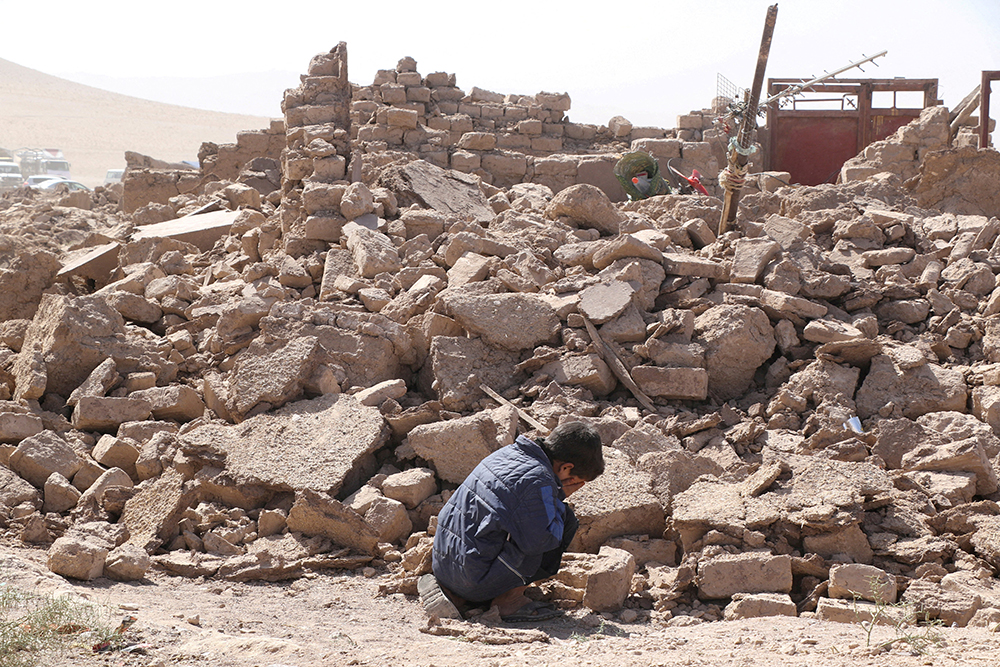
PROSPECT HEIGHTS — After two major earthquakes struck Afghanistan in a matter of days, the country’s Catholic Relief Services representative outlined three focuses of the organization’s current response: the safety and well-being of the CRS staff on the ground, providing immediate support to those who are displaced, and finishing an assessment of damage from the second earthquake.
The earthquakes struck the western province of Herat on Oct. 7 and Oct. 11. Both reportedly were 6.3 magnitude.
Anne Bousquet, the CRS Afghanistan representative, told The Tablet Oct. 12 that the extent of the damage of the second earthquake won’t be clear until the organization’s assessment concludes at the end of the week. Janan Sayiq, a spokesperson for the government, told reporters in Kabul Oct. 11 that at least one person was killed and at least 120 others were injured.
It’s confirmed, however, that the first earthquake was devastating, with over 2,400 people killed and thousands more injured, and thousands of homes destroyed. Bousquet said that the first earthquake affected about 12,000 individuals, or about 1,700 families in total.
“The damage is significant. There have been total villages that have been leveled.” Bousquet said. “The situation is pretty bad, and the needs are great.”
Bousquet explained that most homes in the areas hit by the earthquakes aren’t built to withstand earthquakes of that magnitude. She said that for the most part there’s clay walls with homes on the inside of those walls, a doorway where you walk in, and possibly a small courtyard if multiple families live within the same compound.
There’s often nothing more than wood beams holding the structures up. And because women and children are often the ones inside the homes, they were the ones most affected, she said.
“Women and children were most affected because they’re often inside the home, and when those roofs and walls come down there’s a lot of weight to them especially when there’s some wood beams,” Bousquet explained.
“Just imagine it all crumbling around you, and you can’t get out from underneath the weight of the material. Unfortunately many people died, and a lot of them were women and children.”
In the immediate future, Bousquet said it’s essential to provide those who were displaced emergency shelters that are lighter, such as tents, to mitigate the impact if there were another earthquake or tremors. She said people also need food, water, clothing, and other essential items.
Over the long term, they’re looking at how they can construct stronger housing solutions with winter right around the corner, as well as acquiring items like tarpaulins, blankets, and winter clothes. However, Bousquet cautioned that it may be a while until they can start building because the region is still experiencing repeated tremors in the aftermath of the earthquakes.
“Construction will start as soon as possible, but there’s still repeated tremors going on so I don’t think you’ll see anything until there’s a calm for a while,” Bousquet said.
CRS has approximately 190 staff in Afghanistan who work in three of the five districts of Herat that were most impacted by the earthquake — Injil, Kushk, and Zinda Jan. On Oct. 10, United Nations deputy spokesperson Farhan Haq said Injil and Zinda Jan were hardest hit by the earthquake. In Zinda Jan in particular, he said, there were 1,300 people killed and nearly 500 people still reported missing.
Bousquet said there were no casualties of CRS staff, although many experienced damage significant enough to their homes that it’s not safe to stay there, and the organization is working to provide tents for staff and their families to sleep outside of their homes. The CRS office was also structurally affected, and its international guest house was damaged as well, she said.
While their own situations are sorted out, Bousquet said CRS staff are still working around the clock to help those who were more directly impacted by the earthquake and to finish the assessment of the damage from the second earthquake in conjunction with the United Nations Office for the Coordination of Humanitarian Affairs and the United Nations Children’s Fund.
As recovery efforts continue, another concern is whether or not another earthquake will strike. Earthquakes are common in Afghanistan with a number of fault lines and three tectonic plates nearby. However, quakes are more common in Kabul, not so much in Herat.
“Everybody’s concerned, I mean really concerned,” Bousquet said about the possibility of another earthquake in the province.
“Herat is not known for being on the fault line of earthquakes,” she said. “It usually happens in Kabul. There are lots of tremors and things happening in Kabul, but to have it happening at this magnitude in Herat took everybody by surprise.”
